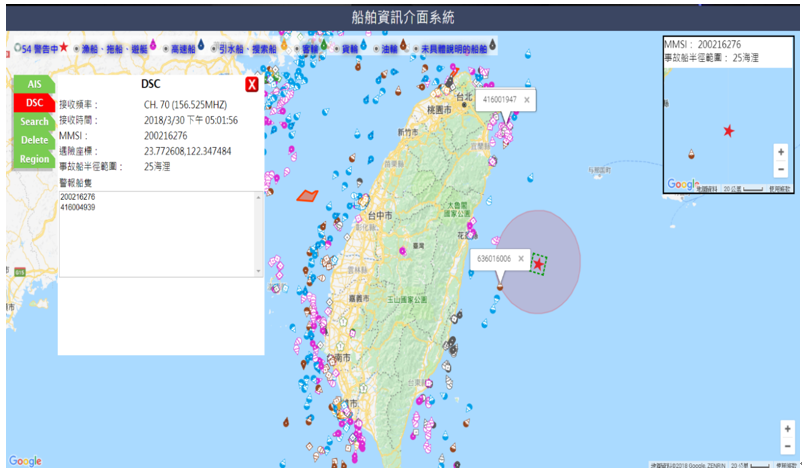Development and application of an intelligent navigation safety system for the Taiwan sea area
- Date:2019-03-07
- Update:2019-03-07
- Department:IOT
Project Overview:
Statistical data of maritime disaster accidents of the Maritime and Port Bureau show that there have been more than 200 maritime disaster accidents of merchant ships and fishing vessels in Taiwan sea area. In view of this, the project is to research the possibility of combining the Automatic Identification System (AIS) and the Digital Selective Calling (DSC) to strengthen the collection of maritime safety basis data and establish an information system, to enhance the safety of the marine transportation system and reduce the loss of life and property.
Cooperated with the Taiwan International Ports Corporation to actively promote the "Taiwan Ports Group Green Harbor Promotion Program", whose main purpose of "Ship Deceleration Examine and Audit System" is to monitor the deceleration of vessels entering and leaving the ports, to reduce carbon dioxide emissions in the port area to protect the environment around the port. Use AIS communication technology to track the deceleration of vessels entering and leaving the ports, and calculate specific ship deceleration data, to plan and establish vessel deceleration examine and audit mechanism in Taiwan's international ports by specific vessel deceleration data. In order to extend the coverage of AIS information, the AIS signal is continuously monitored and forwarded back to the base station through TAIMA STAR during the navigation process, to further optimize the potential covrage area of the AIS information system to safeguard maritime traffic safety.
Research outcomes:
(1)Maritime Disaster Rescue DSC and AIS Integrated System: Integrate the vessel information interface systems of AIS and DSC, and through remote monitoring real time query DSC and AID displayed information, to simplify the ship rescue process and reduce the manpower cost for the coastal station to continuously monitor the vessel distress channel, in order to grasp maritime disaster messages at all times.
(2)Taiwan Port Vessel Deceleration Monitoring Mechanism System: Based on to the methods defined by the Los Angeles Port Ship Deceleration Monitoring Mechanism to obtain integrated average speeds through the vessel deceleration monitoring application built by this Institute, calculate weighted averages based on the number of nautical miles set for each section. When a vessel enters or leaves the port, every 20% deceleration of a vessel’s speed below 12 knots will reducefuel consumption by 40%.
(3)The mobile relay transmission technology is used in the research and development of AIS system: Use the microcontroller to capture AIS information after data processing, use the relay transmission device to forward the AIS data automatically to extend the AIS system information coverage area to about 30 nautical miles, improve the AIS system information transmission and reception distance limit that resulted in incomplete AIS system information, and further optimized the AIS system information coverage area.
Promotion of Outcomes and Benefits :
Regarding the results of the vessel deceleration monitoring mechanism for the seven major ports of Taiwan in 2016, the Ministry of Transportation and Communications held a press conference of "Making a contribution to the improvement of Taiwan's port area and coastal air quality! Let all vessels slow down together!" on September 5, 2017, and presented the project report "Maritime Disaster Rescue DSC and AIS Integrated System" Promotion and Application Seminar to the Department of Aviation and Navigation of the Ministry of Transportation and Communications, National Communications Commission, Coast Guard Administration and Maritime and Port Bureau at the Keelung Coastal Station on September 29, 2017. In the future (2019), this Institute will submit a solution program in response to newly constructed offshore wind power farms that cause problems of increasing risks tovessel navigation safety, integrate the marine array radars based on the maritime disaster rescue DSC and AIS systems, to develop an improved offshore wind farm vessel navigation safety monitoring system to effectively reduce the possibility of navigation accidents caused by offshore wind power development and construction.








